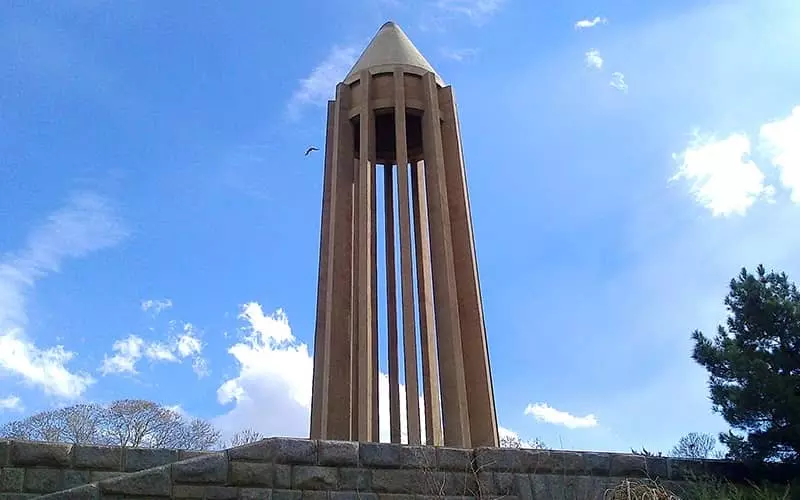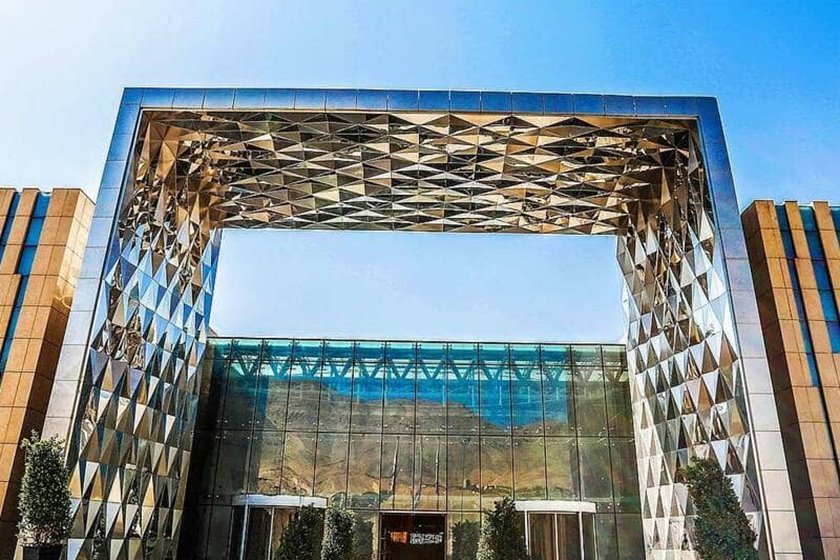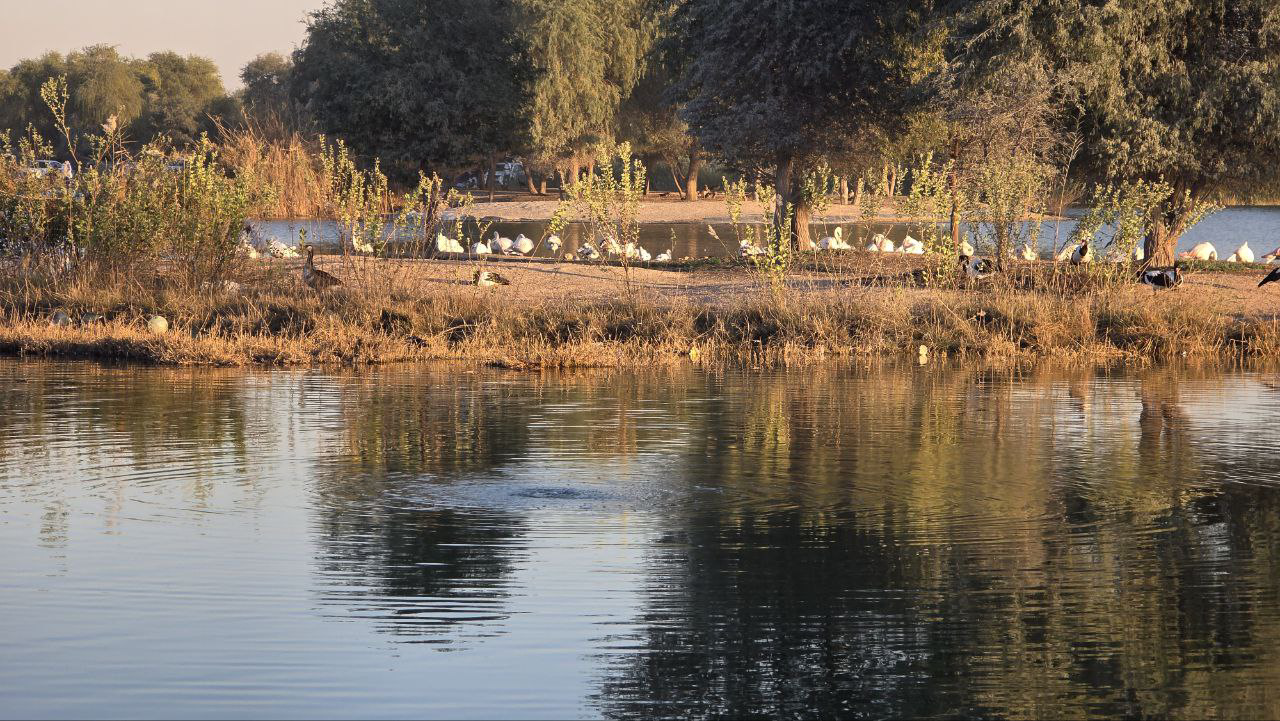Tomb of Abu Ali Sina
The Tomb of Abu Ali Sina, the resting place of the renowned and highly esteemed Persian physician and philosopher who lived in the 4th century AH, is a significant landmark and one of the main attractions in Hamadan. This site is not just a mausoleum; in addition to housing the grave of Sheikh al-Rais (Avicenna), it is also the burial place of Abu Sa’id Dakhduq, a friend of Avicenna( Abu Ali Sina ) , and Abul-Qasim Aref Qazvini, a national poet of Iran. The site also includes a museum dedicated to Avicenna and the science of medicine. The beautiful green spaces surrounding the tomb add to its charm, making it even more appealing. This attraction was registered as a National Monument of Iran in 1997 and draws numerous visitors each year.
Introduction to the Tomb of Abu Ali Sina
The Tomb of Abu Ali Sina is one of the prominent tourist attractions in Hamadan, distinguished by its towering columns and serving as a symbol of the city. This tomb was registered as a National Monument of Iran on May 10, 1997, under registration number 1869. Although the current structure dates back to recent years, it stands out in terms of engineering principles and architectural details compared to many historical sites in the country.
The Tomb of Abu Ali Sina consists of two halls: the northern and southern. Currently, the southern hall is used as a museum for displaying coins, pottery, bronze, and other artifacts, while the northern hall has been designated as a library. Abu Ali Sina grave is located to the right of the tomb’s entrance, with Abu Sa’id Dakhduq’s grave positioned to the left. In the eastern courtyard of the tomb, directly across from the entrance and facing Bouali Street, lies the grave of the national poet of Iran, Abul-Qasim Aref Qazvini.
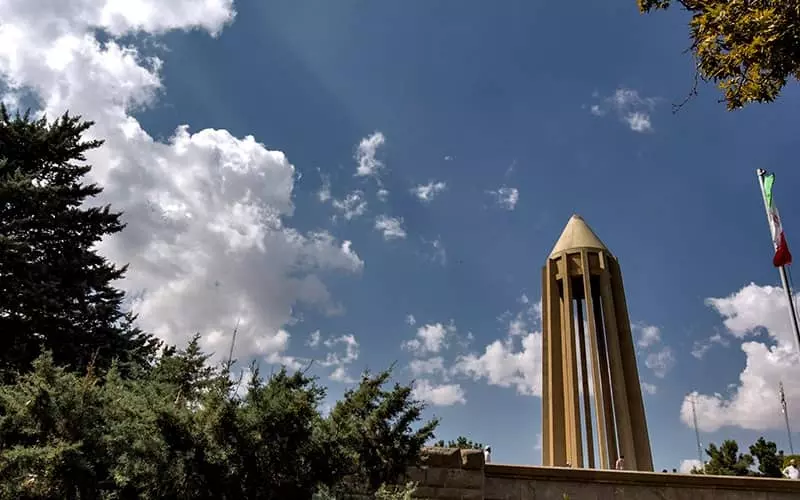
History of the Tomb of Abu Ali Sina
During Abu Ali Sina lifetime, the troops of Shams al-Dawlah Daylami, the ruler of Hamadan at that time, staged a rebellion. Avicenna took refuge in Abu Sa’id’s house for 40 days during this unrest. After his death, he was buried at this location, and shortly thereafter, Abu Sa’id was also laid to rest beside him. At that time, this site was situated behind the southern fortress of Hamadan, and until the late 13th century AH, there was only a small four-arched structure serving as their mausoleum.
Qajar Era
As the four-arched structure deteriorated over time, a Qajar princess named Negar Khanum, daughter of Prince Abbas Mirza and the crown prince of Fath Ali Shah, took the initiative to renew and repair the tomb. She commissioned the construction of a brick dome to replace the old structure, placing two stones—one on Abu Ali Sina grave and one on Abu Sa’id’s. After the new building was constructed, the old gravestones were installed in the foyer of the new tomb. Additionally, a low wooden railing was constructed around the graves of Avicenna and Abu Sa’id inside the tomb.
In 1920, Mohammad Hossein Farid al-Dawlah Golgoon Hamadani built a short wall around Abu Ali Sina grave and constructed a large hall and a smaller one beside the tomb for a library and book storage, along with adding a well and a pool to the complex.
Pahlavi Era
During the reign of Mohammad Reza Pahlavi, members of the National Heritage Society of Iran decided to construct a new tomb for Abu Ali Sina combining old and new architectural styles. Consequently, in June 1945, a design competition for the building was held among engineers and architecture graduates. The design by engineer Houshang Seyhoun was selected by Mr. Mohsen Foroughi and Andre Godard, and Seyhoun was awarded the project.
This design was inspired by the “Gonbad-e Qabus,” one of the greatest architectural masterpieces of Abu Ali Sina era, which is the tomb of Qabus ibn Voshmgir, a poet, calligrapher, and ruler of the Ziyarid dynasty. Although the architectural styles of the two buildings differ significantly, the initial idea of the architect can be understood from this magnificent structure.
In mid-1947, the National Heritage Society decided to execute the building project. At that time, Seyhoun traveled to Paris to complete his studies. Upon learning of the Society’s decision, he began new research and presented the final plans of the tomb as his thesis to the School of Fine Arts in Paris in June 1949. These plans were then sent for execution to the Society in July of the same year. A contract was signed early in 1949 between the National Heritage Society and the National Buildings Company (a partnership of engineer Ebtehaj and associates), and construction of the tomb commenced in June.
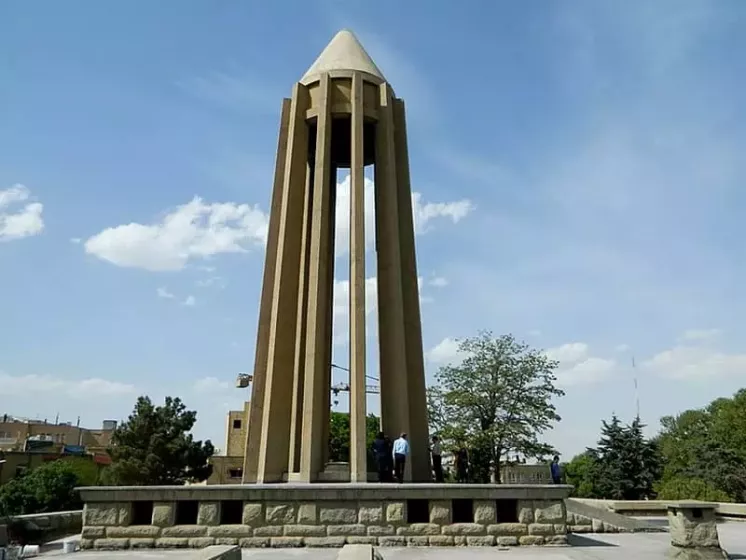
After demolishing the old mausoleum and exhuming the remains of Abu Ali Sina and Abu Sa’id, the skulls and remaining bones were placed in special boxes, sealed, and kept until the new building was completed for reburial.
The construction of the new Tomb of Abu Ali Sina was completed in 1951 and handed over to the representatives of the National Heritage Society in February of that year. On Friday, May 1, 1952, the seals and wax on the boxes containing Abu Ali Sina and Abu Sa’id’s remains were removed, and the bones were carefully reburied according to religious and traditional practices.
Best Time to Visit the Tomb of Abu Ali Sina
Hamadan experiences cold winters, making spring and summer the ideal times to visit the city and enjoy the pleasant weather. During these seasons, a visit to the Tomb of Abu Ali Sina is sure to be a memorable experience.
Architecture of the Tomb of Abu Ali Sina
The Tomb of Abu Ali Sina is situated on a 3,090 square meter plot, with the building’s footprint covering 1,792 square meters. The design of the tomb combines elements of ancient Iranian and post-Islamic Iranian architecture. The architectural elements and surroundings draw inspiration from traditional Iranian art. The tomb’s tower is influenced by the Gonbad-e Qabus, the gardens reflect traditional Iranian garden design, the water features are inspired by traditional Persian pools, and the stone façade uses granite reminiscent of ancient Iranian palaces.
Engineer Houshang Seyhoun incorporated elements from ancient Egyptian, Iranian, and Greek architecture in the lower part of the building, while the upper part showcases the architecture of the Gonbad-e Qabus. This design symbolizes Abu Ali Sina as a great Islamic philosopher whose thoughts were built upon the knowledge of ancient civilizations. The large, rough stones in the lower sections of the structure evoke strength and power, while the elegance and grandeur of the tower and its base contrast with the rough stones below.
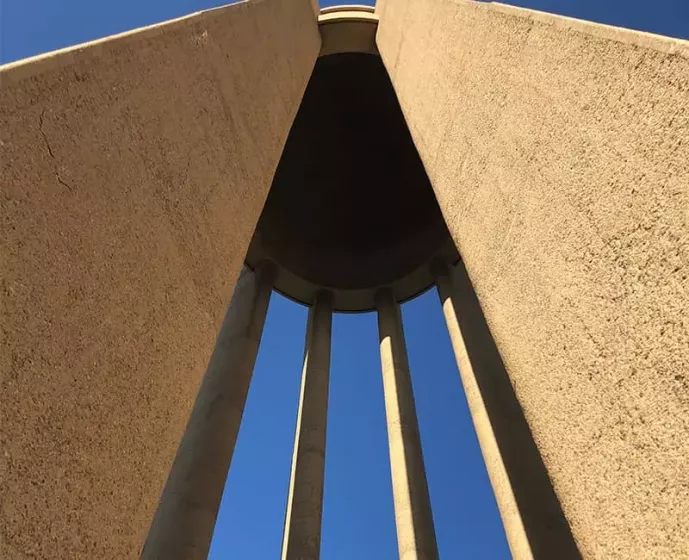
The architectural style of Abu Ali Sina tomb differs from that of the Gonbad-e Qabus. Notably, the Gonbad-e Qabus has 10 columns, while Abu Ali Sina tomb features 12 columns, representing the 12 branches of Avicenna’s knowledge. Additionally, the spacing between the columns in Abu Ali Sina dome is open, whereas it is closed in the Gonbad-e Qabus. The two structures also differ in size, with Avicenna’s tomb being approximately half the size of the Gonbad-e Qabus. Interestingly, the entrance of the tomb has 10 columns, symbolizing that the building was erected 10 centuries after Avicenna.
Features of the Tomb of Abu Ali Sina
One of the most striking features of the tomb is the large, single marble slab measuring 2.55 meters in length and 1 meter in width, located among the 12 columns of the tower. This slab bears an inscription in Thuluth script. During construction, a large marble slab was initially prepared for this part, but it broke in an accident. Consequently, another slab was sourced from near Lake Urmia and brought to Hamadan.
The tower’s columns are also noteworthy. Each column’s height from the floor of the tomb to beneath the dome is nearly 23 meters. The base of each column measures 1.17 meters in width, tapering to 92 centimeters at the top. The conical dome rises approximately 6 meters, making the total height of the tomb from floor to the top over 28 meters.
Upon entering the building, visitors encounter a square courtyard adorned with 20 verses from the famous “Ainiyyah” poem, written in Thuluth script on the walls. This poem, a work of Abu Ali Sina literary contributions in wisdom and philosophy, addresses the stages of the human soul’s journey and its relationship with the physical world. These verses are inscribed on 40 marble plaques, each measuring 1.10 meters in length and 0.5 meters in width.
Complementing the tomb is a semi-circular garden with green space, where a statue of Abu Ali Sina holding a book stands on the eastern side of the courtyard.
Different Sections of the Tomb of Abu Ali Sina
Library
One of the initiatives taken by the Millennial Committee for Abu Ali Sinawas the establishment of a library adjacent to his tomb. The committee believed that since Abu Ali Sina was a globally renowned philosopher and scholar, scholarly communities worldwide should contribute to the creation of his library. Consequently, in 1950, a call for contributions was issued in Persian, Arabic, French, and English, requesting authors, cultural institutions, and publishers both Iranian and foreign, to send books to the National Heritage Society.
Initially, the library had 649 books and was referred to as the Abu Ali Sina Reading House. Following the announcement, the collection expanded. Today, the library holds around 8,000 books, including approximately 30 manuscripts and 590 volumes in languages such as French, English, and German.
Statue of Abu Ali Sina
Historical images of Abu Ali Sina found in old books, libraries, and churches, as well as in European translations of his works, lack authenticity and are mostly speculative. To address this, the National Heritage Society decided to create a statue of him. This required designing an accurate representation of Sheikh al-Rais based on available sources and documents. Various committees comprising scholars familiar with Abu Ali Sina works and biographies were formed. Using information from Avicenna’s own writings, his student Abu Ubaid, and the writings of Bayhaqi in “Sawan al-Hikmah,” a portrait was created by the renowned sculptor Abolhassan Sedighi. This portrait was approved in the 21st meeting of the National Heritage Society’s founding board. Sedighi then used this portrait to create a statue of Avicenna, which was completed in January 1950. The statue, which stands 3.10 meters tall, 90 centimeters wide, and weighs approximately four tons, is made of white marble and is displayed on a base in Bouali Square in Hamadan. The base of the statue features verses written in Nastaliq script.
Tomb Grounds
The tomb of Sheikh Abu Ali Sina is located in Bouali Square, within a beautifully landscaped area featuring a semi-circular garden with green spaces. The entrance courtyard includes gardens and fountains that evoke the charm of traditional Iranian gardens.
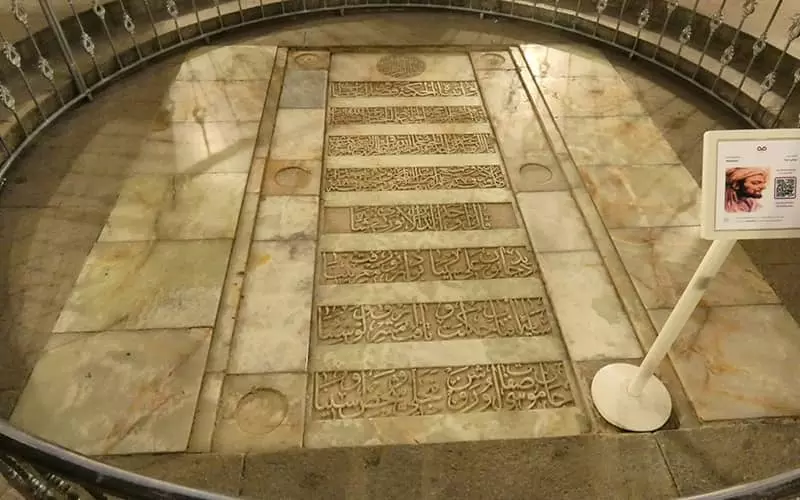
Abu Ali Sina Museum
The southern hall of Abu Ali Sina tomb has been designated as a museum since 1951. It houses a collection of coins, pottery, bronze artifacts, and other items from before and during the Islamic era. One of the most intriguing exhibits is a photograph of Abu Ali Sina skull, which was apparently taken during the demolition of the old mausoleum. The museum also displays a collection of old medicinal bottles, surgical instruments, and information about medicinal plants.
Who Was Abu Ali Sina ?
Abu Ali Sina , born in 980 CE in Bukhara and passing away in 1037 CE in Hamadan, was a polymath and one of the most influential philosophers and scientists of the Islamic Golden Age. His contributions spanned various fields including mathematics, astronomy, physics, chemistry, psychology, geology, geography, poetry, literature, philosophy, logic, and medicine. Abu Ali Sina works in Aristotelian philosophy and medicine are of significant importance and remain key references in these disciplines. His seminal medical text, The Canon of Medicine (Al-Qanun fi al-Tibb), is considered one of the most renowned works in the history of medicine and continues to be utilized in research. His birthday is celebrated as Physician’s Day.
Given that Arabic was the dominant language for scholarly works of the time, Abu Ali Sina and other scholars of his era wrote their books in Arabic. Later, some of these works were translated into other languages, including Persian. Abu Ali Sina also contributed to Persian literature with over 20 attributed works and wrote about 250 short treatises and letters on topics relevant in the Middle Ages.
Abu Ali Sina , one of the great Iranian scholars, was born in the village of Afshana in Bukhara, which was the capital of the Sassanian Empire and is now part of present-day Uzbekistan. His life was full of ups and downs. This remarkable scholar was renowned not only for his skills in medicine but also as a philosopher, making significant contributions to fields such as ethics and philosophy. He was also celebrated as a mathematician, astronomer, physicist, geographer, chemist, geologist, and poet.
During his lifetime, Abu Ali Sina served as a physician to many kings and was given various titles, including Sheikh al-Rais, Sharaf al-Mulk, Hujjat al-Haqq, and Shahzadeh of Physicians. Abu Ali Sina passed away in the city of Hamadan due to illness, and his remains are still honored by Iranians. Today, his tomb is one of the notable attractions in Hamadan.
Visiting the Tomb of Abu Ali Sina
Visiting Hours
The Tomb of Abu Ali Sina is open daily from 8:30 AM to 8:00 PM during the first half of the year and from 8:30 AM to 5:00 PM during the second half of the year. The site is closed on mourning days, including 28th of Safar, Ashura, Tasu’a, the martyrdom of Imam Ja’far al-Sadiq (AS), 21st of Ramadan, and the anniversary of Imam Khomeini’s passing.
Ticket Price
As of 2024, the ticket price for the Tomb of Abu Ali Sina is 25,000 IRR per person.
Nearby Attractions
The Tomb of Baba Taher, the Hegmataneh Museum, and the Museum of Celebrities are located relatively close to Abu Ali Sina tomb and are worth visiting.
Frequently Asked Questions
Where is the Tomb of Abu Ali Sina located? The tomb is situated in Bouali Square in Hamadan.
What are the architectural features of the Tomb of Abu Ali Sina ? The tower of the tomb is inspired by the Gonbad-e Qabus, the gardens are reminiscent of traditional Iranian gardens, the water features are based on traditional Persian pools, and the stone façade uses granite inspired by ancient Iranian palaces.
What sections does the Tomb of Abu Ali Sina include? The tomb complex includes a statue of Abu Ali Sina , a library, the Abu Ali Sina Museum, and the surrounding grounds.
How much is the ticket to visit the Tomb of Abu Ali Sina ? The ticket price for Iranian tourists in 2024 is 25,000 IRR.

